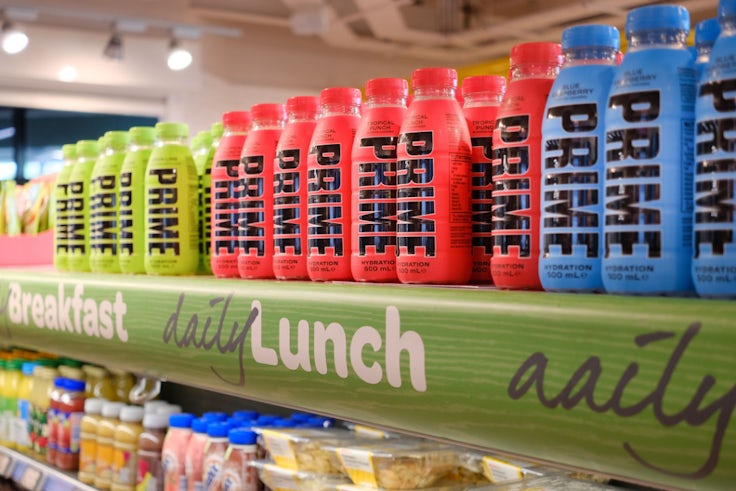

Internet creators have been capturing the attention of marketing circles recently. Creators, or content creators, are people who have become famous for creating content for the internet. But it has been these creators’ products and brands that have caught the attention of the marketing industry, rather than the content they produce.
The product that has captured the most attention is the KSI and Logan Paul energy drink, Prime.
Although Prime made huge sales in its first year ($1.2bn projected 2023 sales), in the first quarter of 2024 UK sales for Prime fell 50% year over year, and it has been reduced to the bargain bin in some cases. Now, this might be a case of the product ultimately being more important than promotion (everyone I’ve spoken to is less than complementary about its taste), but it did make me think about the creators.
Over the last decade, I’ve been watching how the creators have developed their brands, so I thought it time to look at who these creators are, how they might be building their own brands, what that might mean for the products they are promoting, and for brands that follow more traditional pathways.
Who are creators?
People often compare creators to celebrities, and say that celebrity product endorsement has been around for decades. Of course, this is true – whether it’s George Foreman and his grill, or Paul Newman and his salad dressing.
But creators differ in some important ways, and one of these is their more direct route to becoming famous. Unlike more traditional celebrities, these aren’t people who were great actors or musicians, sports people or writers, who’ve become famous as a by-product of being great at something specific. They’ve become famous by creating their own online content, in their own way, across digital platforms.
There are many digital platforms that provide the basis for these creators – from YouTube to TikTok, Instagram to Twitch. Influential YouTube creators – such as MrBeast, Like Nastya, PewDiePie, Logan Paul and KSI – have all spent considerable time and energy in building their audiences, and their own brands, on their platforms. Take a look at some YouTube subscriber numbers as evidence of their reach: MrBeast has 255 million subscribers on the platform, Like Nastya has 115 million, while PewDiePie has 111 million.
‘You can’t cheat the fundamentals’: Why Prime has been reduced to the bargain bin
If the subscribers for the world’s biggest YouTubers were populations of countries, they’d all be markets significantly bigger than the UK.
While the power of these creators’ personal brands is evidenced by their large subscriber base, many have decided to take the plunge into more traditional brands.
So, how does the creator brand building differ from the traditional business model of brand building?
Traditional product or market-orientation
When you’re trained in marketing, you are taught there are two ways to orient a business: the product, and the market. In simple terms, your business either focuses on the product (or service) that your business wants to sell, or you focus on what the market is actually saying it wants or needs from a business such as yours.
These two ways of thinking about your business are known as being product-oriented or market-oriented. In an ideal world, these would work hand-in-hand, with marketers switching from one to the other depending on where the business is at. But all too often, one is ignored in preference of the other.
Don’t listen to the industry sages, they’re not your ad’s target
In my working life at Halo, I regularly deal with B2B and B2C businesses, both large and small. Across the board, many will claim to be market-oriented, because of course you should always have a good understanding of what the market wants from you.
But in my experience, I have found that most businesses will be far more inward looking and product-oriented than they would like to admit. Most businesses are much more focused on developing their product or service and then finding an audience to sell that to, rather than putting the requirements of the market front and centre and changing their offering accordingly. I would even suggest that the vast majority (if not all) creative agencies fall into being more service-oriented than they should be – and I include Halo in that.
Product-orientation
Consumers (or clients) buy products (or services) because businesses have experience and expertise in creating a product within a specific category, and they build brands around these products. When you think about the value chain, it will be something like this:
Make products > create brand > find an audience > sell product.
The product (or service) is the star of the show.
This means that businesses, and brands, are very linked to specific categories. It is very rare that a brand will break out very far from its category. It’s highly unlikely that Ben & Jerry’s is going to launch bottled water, or that Colgate is going to release a shower gel. There are a few brands that create brand extensions out of category. Virgin, for one, is a bit of an outlier, breaking out of its original category by launching various brands, from trains to planes, TV to festivals.
Market-orientation
Market-orientation is often described as a more organisational culture, consisting of three behavioural components – customer orientation, competitor orientation and interfunctional coordination. Whether it is customer trends, competitor activities or market forces, the competitive advantage exists external to the business, and so you focus on shaping or flexing the product (or service) you sell to be able win better in this shifting landscape. I’d suggest the value chain looks a little bit like this:
Analyse market > make product > create brand > sell product.
The market changes are the star of the show.
But, although this model has an increased focus on the audience, it is still aligned with a competitive set and a market that is associated with a specific category (product or service).
Audience-orientation?
So, what about ‘creator brands’, and how are they being built? I’d suggest that the creators are actually using a third model: audience-orientation.
This model favoured by creators has a distinct focus; one that is aligned to a market-oriented approach but which focuses on one aspect – the audience. The simple fact is the creators built their audience, and brands, first and might add products into the mix later. For creators, their value chain might look a bit like this:
Find an audience > create brand > create content > sell products.
The audience is the star of the show.
What these creators are doing is creating an audience and then turning them into consumers. They’re not targeting consumers and trying to turn them into fans.
For creators, the role of their brand is 100% about the connection with its audience. Because they’re not wedded to an original category (product or service), the types of products and associated brands they launch can be wild and varied.
Take a look at MrBeast as an example. Outside of his multiple YouTube channels, MrBeast also has MrBeast Burger (virtual burger restaurant), Feastables (MrBeast chocolate bars), Team Trees (tree planting organisation), Beast Philanthropy (good causes), among other things.
Look at what Sidemen (home of KSI) have achieved, opening their first physical store in Bluewater in Kent last year. And consider KSI and Logan Paul’s brand Prime.
What this all means is the creator has the ability to align their brand to any product, in any category, with little danger of damaging the master brand (that of the creator). As long as the product fits their brand, it is fine.
The audience is the star
These creator brands are all about creating an audience, and then evolving with their audience. Now, this is due to the digital channels, such as YouTube and TikTok, enabling people to earn an income, and become hugely famous, through creating content. Creators may not be famous for something specific (acting or music, sports or writing), but that opens them up to even more opportunities. Because they don’t have the gatekeepers of a record label, football club or similar, they are able to evolve and adjust with whatever their audience prefers (or likes). And who is going to accuse a creator of selling-out, when getting likes and clicks (and purchases) was the point from the beginning.
Around 20 years ago, the term ‘co-creation’ was coined by marketing professors CK Prahalad and Venkatram Ramaswamy in their book The Future of Competition: Co-Creating Unique Value With Customers. In this book, the authors explore the convergence of industries and technologies; ubiquitous connectivity and globalisation; and the consequence of the evolving role of the consumer from passive recipient to active co-creator of value.
Ignore the sceptics, brands can be built on digital platforms
They describe this “consumer-centric” view in opposition to the traditional “company-centric” view. In the traditional view, the consumer is not part of the value creation process, while in the consumer-centric view the consumer plays a key role in it. Today, we see people like strategist Zoe Scaman doing great work on things like gatekeeper-free communities and “fandoms”.
This audience-oriented way of working is a reversal of the traditional business model of creating products or services, and then finding an audience to sell them to.
What these creators are doing is creating an audience and then turning them into consumers. They’re not targeting consumers and trying to turn them into fans.
The future
The largest of the creator brands have created link ups with product manufacturers that have all of the distribution deals already set up. For example, KSI & Logan Paul’s brand Prime energy drink is made by Refresco, which already works with the world’s leading retailers.
So, maybe the product-oriented businesses still have a role to play in this new creator economy after all?
I’ve been shaping brands for businesses for over 25 years, and the one thing I have learned is constant, is change. The brands in the strongest position are those that are able to adjust and evolve to the market forces at play, and the audiences’ shifting demands. Evolution of brand is essential in this emergent landscape.
Putting an audience at the centre of your offering and your brand, and then evolving with that audience, is here to stay. For forward-looking businesses, it might be time to pay more attention to these audience-oriented brand building techniques of the creators.
link







